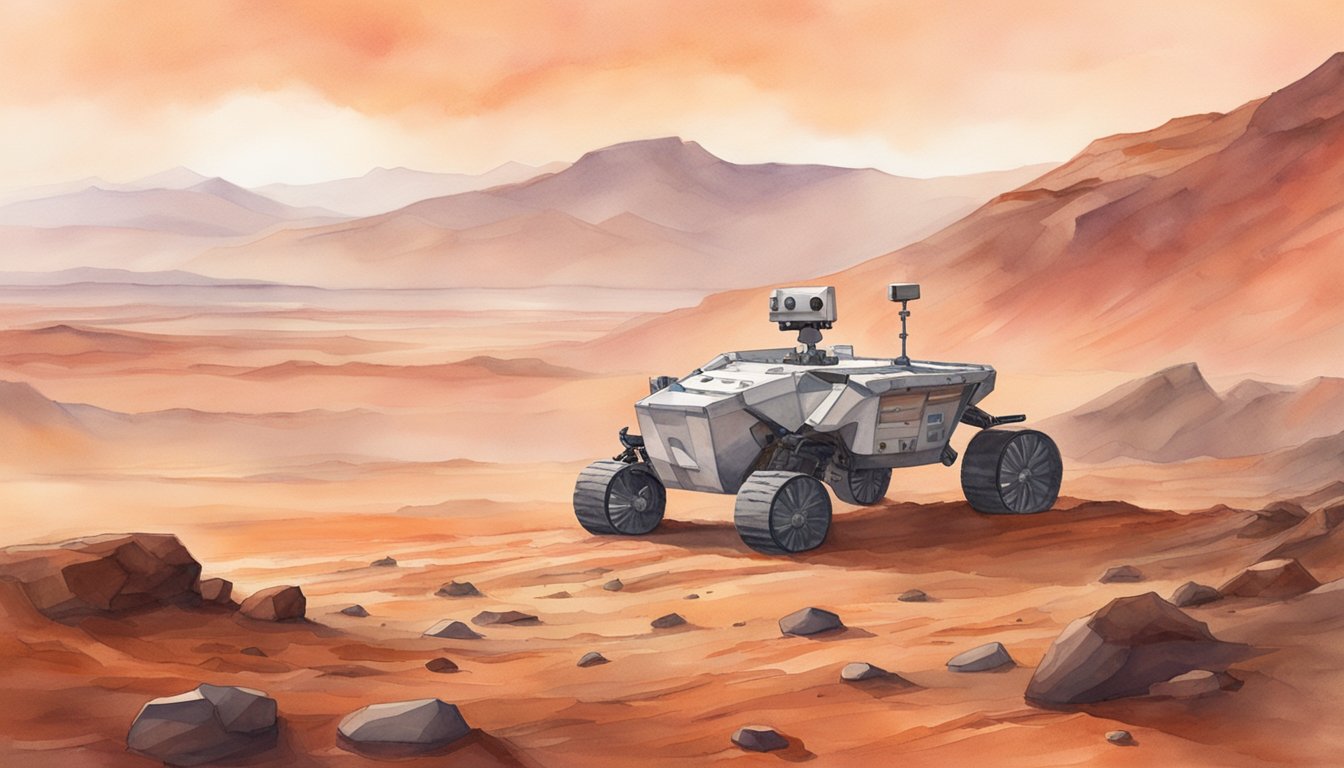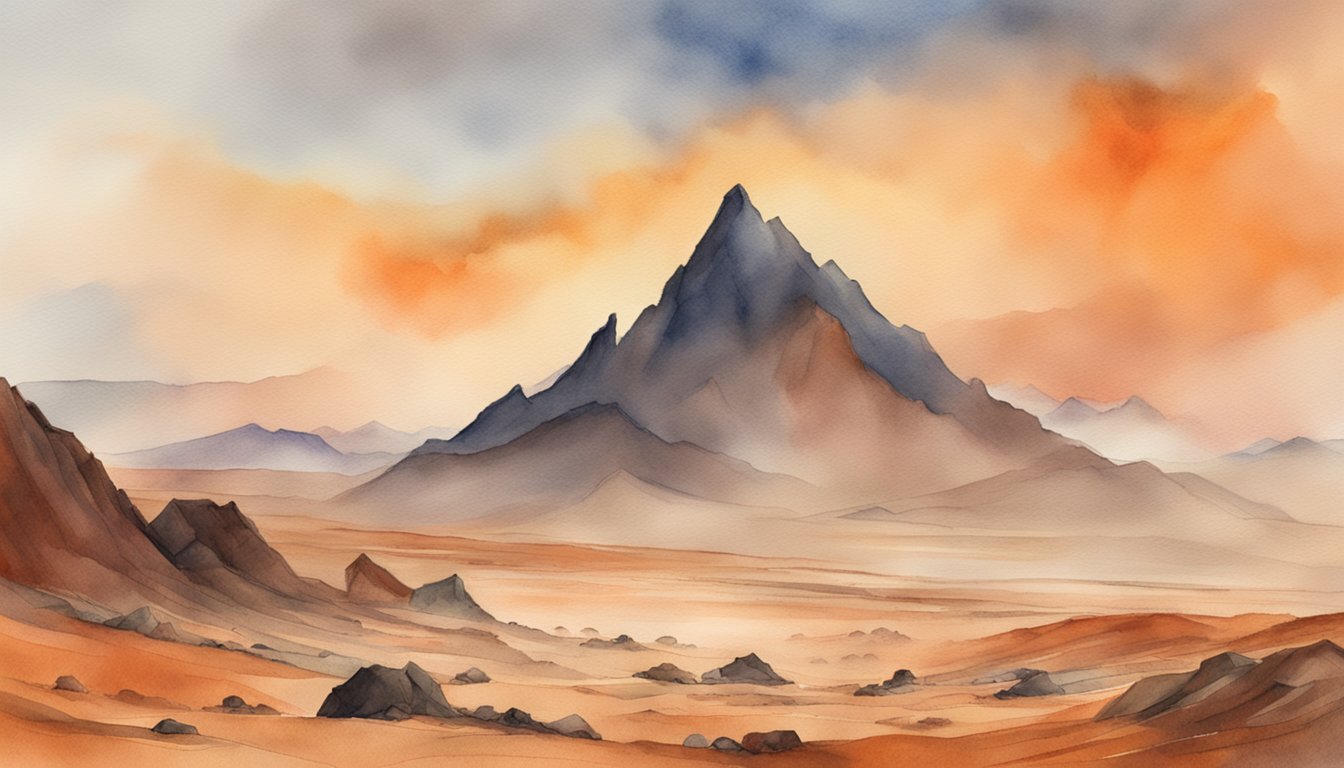Understanding Mars
Mars, often called the Red Planet, holds a special place in our quest to understand our solar system. With a cold, desert-like climate and striking geological features, it beckons with the possibility of past or present life.
Planetary Characteristics
Mars, the fourth planet from the sun, is a dusty, cold, desert world with a very thin atmosphere. The Martian landscape is composed of vast plains, towering volcanoes, like Olympus Mons, and deep valleys such as Valles Marineris. Its icy caps at the poles are a stark reminder of its frigid climate, with surface temperatures averaging about -80 degrees Fahrenheit.
- Atmosphere: The Martian atmosphere is thin and is made up mainly of carbon dioxide, with traces of nitrogen and argon.
- Temperature and Climate: While Mars experiences four seasons like Earth, temperatures can plunge to nearly -195 degrees Fahrenheit near the poles during winter.
- Geological Features: The red planet is home to the largest volcano and the deepest, longest canyon in the solar system.
Mars has two moons, Phobos and Deimos, which are thought to be captured asteroids. Unlike our moon, these Martian moons are small and irregularly shaped.
Historical Mars Missions
Over the decades, NASA, with its Jet Propulsion Laboratory in Pasadena, California, has spearheaded a series of missions to Mars to understand more about the planet’s past and potential for life. Notable rovers that have roamed the Martian surface include the Mars Exploration Rovers, Opportunity and its twin Spirit, which have provided invaluable data about the Martian surface and geology.
- Mars Exploration Rovers: Beginning with the launch of Pathfinder in 1996 and its Sojourner rover, Mars has been visited by a succession of increasingly sophisticated rovers.
- Mars 2020: The Perseverance rover, part of the Mars 2020 mission, landed in February 2021, with the latest technologies and experiments designed to seek signs of past life and collect soil and rock samples.
The Curiosity rover, which landed in 2012, has found evidence of ancient freshwater habitats and is assessing the habitability of Mars. These missions leverage advanced technologies to navigate the Martian terrain and analyze soil and rock samples.
Life on Mars: Possibilities and Discoveries

The red planet holds a treasure trove of mysteries, with scientists around the globe captivated by the possibilities of life on Mars. From habitability factors to compelling geological evidence, each discovery takes us a step closer to answering the age-old question: Are we alone in the universe?
Habitability and Astrobiology
Mars presents a tantalizing environment that could support life, especially within its brines and ice. Astrobiologists have identified essential elements like hydrogen and oxidants that suggest Mars could be a habitable world. Studies suggest that areas like Jezero Crater and Gale Crater could have once harbored water flow and even lakes, providing a potential habitat for life.
Evidence and Research
A pivotal aspect of Martian exploration is the hunt for biosignatures — signs of past life. Organic molecules found in Martian soil and rocks hint at a history more complex than barren landscapes. Instruments like Sherloc on the Perseverance rover actively analyze these samples for organic matter. Every discovery, from methane spikes to radiation-resistant microbe analogs like Deinococcus radiodurans, adds a piece to the puzzle.
Ongoing Experiments and Future Prospects
The exploration of Mars is ongoing, with a focus on in-situ analyses and future sample return missions. For instance, MOXIE, the Oxygen In-Situ Resource Utilization Experiment, demonstrates producing oxygen from Martian carbon dioxide, key for future human exploration. Meanwhile, studies on extremophiles provide insights into the survival strategies potential Martian life forms might employ.
Potential Life Forms and Survival
One ponders the kind of life that might call Mars home. Microbial life, possibly similar to Earth’s extremophiles, could exist in harsh conditions, shielded from radiation beneath Mars’ surface. Adaptations allowing survival in low-energy environments hint at the profound resilience life can exhibit. Scientists remain vigilant for microbial spores or single-celled organisms that can withstand Mars’ hostile environment.
Geological Studies and Surface Analysis
Mars’ geology reveals clues to its habitability. Through advanced instruments like PIXL, scientists analyze rock chemistry, the pH level, and the presence of nutrients at a microscale. The geological record within Martian rocks, soil, and potential ancient river deltas carries a narrative of Mars’ climatic history and its capacity to support life.
The sediments and substrates uncovered by these studies enrich the scientific community’s comprehension of Mars and spur the imagination regarding the profound question of life beyond Earth. With relentless inquiry and technological innovation, the Mars exploration program continues to uncover the secrets of our celestial neighbor, piecing together the enigmatic history and future of life on Mars.
Challenges and Considerations

Life on Mars presents a medley of trials, each more intriguing than the last, where science fiction meets harsh reality. Martian settlers will grapple with an array of technological and logistical hurdles, all worthy of a cosmic saga.
Technological and Logistical Hurdles
Creating a sustainable life on Mars hinges on surmounting a series of technological and logistical hurdles. One pressing issue is the management of desiccation due to Mars’ dry atmosphere. Maintaining physical health in reduced gravity will also be a concern, affecting everything from muscle tone to bone density. Temperature extremes on Mars are no small feat, with fluctuations that can range from a balmy 20°C down to a frigid -125°C.
Mars’ EH (Electrochemical Potential of Hydrogen) and radiation levels are markedly different from Earth’s, making the development of shielded habitats essential. High radiation not only poses a threat to human health but can also degrade electronic systems over time.
Moreover, Mars’ soil contains sulfate compounds that may interfere with the agricultural technologies required for food production. The Martian obliquity, or tilt of its axis, causes significant climate variations which, in turn, impact seasonal solar energy availability. These energy fluctuations necessitate innovative energy storage solutions to power the habitat and life support systems continuously.
The technologies designed to keep humans alive on Mars, from habitation modules to space suits, must be robust yet adaptable. Mars rovers and other vehicles not only have to be operable over difficult terrain but also capable of withstanding wear and tear from Martian dust; the development of such a versatile vehicle capable of operating under these conditions is a key goal.
Harnessing solar energy will be particularly challenging due to the omnipresent dust and the farther distance from the sun. Solar panel technologies are therefore being re-envisioned to maximize efficiency and durability in the Martian environment.
Life on Mars isn’t just a dream—it’s a future mosaic of solutions, each tailored to meet the Red Planet’s extreme conditions with our ingenuity. If humanity’s track record for overcoming the impossible is anything to go by, the hurdles of living on Mars may very well transform into the stepping stones of interplanetary colonization.

